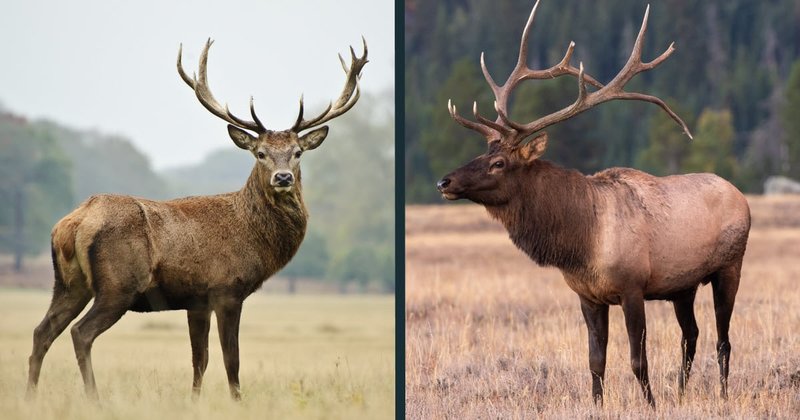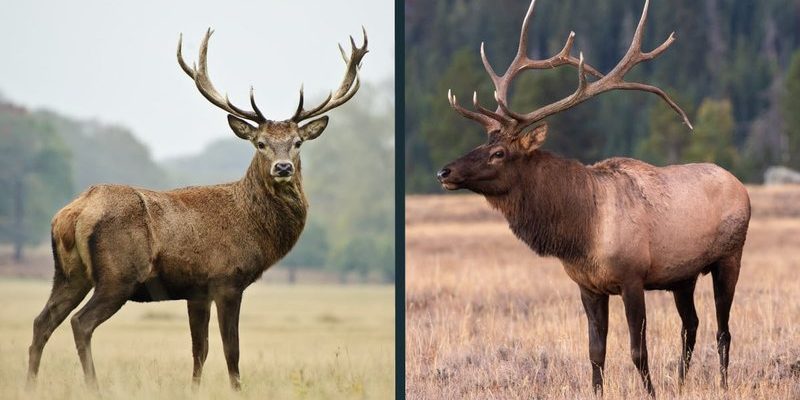
In this article, we’ll explore **10 animals that resemble the wapiti** in terms of appearance, habitat, and behavior. By the end, you’ll be equipped with the knowledge to spot the differences. Think of it as a wildlife version of comparing friends: they may all share a love for the outdoors, but each has its quirks that make them unique.
The Red Deer
The red deer is one of the most similar animals to the wapiti, and it’s easy to see why. Both species belong to the Cervidae family and share a lot of physical traits. The red deer is found mostly in Europe and parts of Asia and can weigh between 400 to 600 pounds.
What’s striking about red deer is their antlers, which are similar in shape to those of a wapiti. However, red deer antlers typically have fewer tines (the points on the antlers).
You might also notice that red deer have a lighter, reddish-brown coat that can shift with the seasons—darker in winter and lighter in summer. If you ever come across one, look closely at the size of the antlers and the coat color; they’re key identifiers.
Key Differences
- Antler Shape: Fewer tines compared to wapiti.
- Body Color: More reddish-brown coat.
- Size: Generally lighter weight than wapiti.
The Moose
Moose are the largest members of the deer family and share a certain ruggedness with wapiti. Imagine a wapiti’s elegance but add a hefty dose of size and unique features. Moose have long legs, a distinctive bulbous nose, and a large dewlap (or “bell”) hanging from their throats.
While both animals thrive in wooded areas, moose prefer wetlands and are often seen wading through water. Their diet consists mainly of aquatic plants, which is quite different from the wapiti’s grazing habits.
To tell them apart, just look for those long legs and the moose’s unique nose. It’s like comparing a dancer to a sumo wrestler—both are impressive, but they embody different forms.
Key Differences
- Size: Moose are significantly larger.
- Nose Shape: Moose have a long, bulbous nose.
- Dewlap: Moose sport a distinctive bell.
The Sika Deer
Sika deer might look smaller than wapiti, but they carry a similar grace in their movements. Originating from East Asia, these deer have unique spotted coats, which can vary from light to dark brown.
One standout feature of sika deer is their vocalizations—they’re known for making loud, barking calls, unlike the quieter wapiti. Additionally, sika deer are smaller, averaging about 100 to 200 pounds, which makes them quite different from a wapiti.
If you spot one, pay attention to the spotted coat and the distinctive sounds; they’re the giveaway characteristics that set them apart from their larger cousins.
Key Differences
- Size: Much smaller than wapiti.
- Coat Patterns: Have spots, unlike wapiti.
- Vocalizations: Known for their loud barking.
The Caribou
Caribou, also known as reindeer in many parts of the world, share habitats with wapiti, especially in the colder northern regions. These animals are quite fascinating, with both males and females growing antlers—something unique in the deer family.
While caribou share a similar build with wapiti, their antlers are more palmated (having a flattened shape) and typically are larger relative to their body size. They’re also known to migrate dramatically over long distances, unlike the more sedentary wapiti.
If you’re in their territory, look for caribou’s distinctive antler shape and their social behavior, often seen in groups, which sets them apart from the usually solitary wapiti.
Key Differences
- Antler Shape: More palmated than wapiti.
- Migration: They migrate in herds.
- Behavior: Usually more social.
The Bongo
Switching gears a bit, the bongo is a striking animal that, while not a direct relative, shares some similarities in body structure with wapiti. Native to the forests of Central and West Africa, bongos have long, spiraled horns and striking orange-brown coats with white stripes.
Unlike wapiti, bongos are primarily forest dwellers, which makes their habitat quite different. They’re also much smaller, with adult bongos weighing in at about 400 to 900 pounds.
When trying to identify one, take note of the bongo’s striking coloration and forest preference. Their unique markings are vivid and memorable, making them stand out against the green foliage.
Key Differences
- Horns: Spiraled horns, unlike wapiti.
- Size: Generally smaller and more compact.
- Habitat: Prefer dense forests, not open grasslands.
The Nilgai
The nilgai, or blue bull, is an intriguing bovid found in India and Nepal. Though not a deer, its build and some of its habits can remind you of wapiti. Nilgai are the largest antelope species in Asia, with males standing tall on slender legs and having a bluish-grey coat.
One of the most striking characteristics of nilgai is their evident sexual dimorphism—males are larger and more robust than females, reminiscent of how wapiti males are larger and more robust than females. However, nilgai lack antlers, and instead, males have long, curving horns.
When observing nilgai, their size and coat coloration can help you distinguish them from wapiti easily. Think of them as the less flashy cousin in the deer family tree.
Key Differences
- Species: Not a deer; they’re antelope.
- Horns: Curved horns instead of antlers.
- Color: Bluish-grey coat, unlike wapiti.
The Axis Deer
Axis deer, also known as chital, are another species that displays remarkable similarities to wapiti. Found in India and Sri Lanka, they’re known for their beautiful spotted coat and graceful movements.
Axis deer are smaller than wapiti, usually weighing between 100 to 150 pounds. Their most distinguishing feature is their coat covered in white spots, which helps them blend into their forested surroundings.
When trying to differentiate between the two, keep an eye on the size and coat patterns. While both have a graceful presence, the axis deer’s spots are a clear giveaway.
Key Differences
- Size: Smaller and lighter than wapiti.
- Coat Patterns: Spotted pattern, unlike wapiti.
- Habitat: More forest-oriented as opposed to open lands.
The Pere David’s Deer
Pere David’s deer is a unique species native to China, distinguished by its long, flat antlers that resemble those of the moose. This deer was once thought to be extinct in the wild but has made a comeback due to conservation efforts.
Though they share a similar body shape with wapiti, Pere David’s deer are more robust and shorter in stature. Their coat is a light brown, and they have a large, broad face that sets them apart.
If you’re keen on identifying this deer, look for the unique antler shape and the broader face. They have a certain charm that’s hard to miss thanks to their distinctive features.
Key Differences
- Antler Shape: Flat, broad antlers versus wapiti.
- Stature: Shorter and more robust.
- Face Shape: Broader face compared to wapiti.
The Elk (North American Elk)
Lastly, let’s not forget that the wapiti is actually a type of elk. In North America, the terms are often used interchangeably, but different regions may refer to them by different names.
While wapiti and elk share many characteristics, regional variations can lead to differences in size and antler configurations. Elk can vary quite a bit depending on where they’re found, with some being smaller and others larger.
When it comes to telling them apart, focus on the regional traits and the antler shapes. Since they’re so closely related, the differences can sometimes be subtle.
Key Differences
- Regional Variations: Size and antler differences based on location.
- Habitat: Preferences can differ based on regions.
- Behavior: Different vocalizations and social structures.
In conclusion, the wapiti is just one of many fascinating animals that share traits with others in the deer family and beyond. By understanding their identifiers, you’ll feel more confident next time you’re out observing wildlife. Whether you’re hiking in the forest or just curious about these beautiful creatures, knowing how to tell them apart adds an extra layer of appreciation. So, keep these tips in mind, and enjoy your next wildlife adventure!

